The Haitian Revolution

In addition to the Indian troubles and the European war across the Atlantic, another bloody conflict to the south polarized and even terrorized many Americans in the 1790s. The French colony of Saint Domingue, in the western third of the large Caribbean island of Hispaniola, became engulfed in revolution starting in 1791. Bloody war raged for more than a decade, resulting in 1804 in the birth of the Republic of Haiti, the first and only independent black state to arise out of a successful slave revolution.[[LP Spot Map: SM09.02 Haitian Revolution, 1791–1804/
The Haitian Revolution was a complex event involving many participants, including the diverse local population and, eventually, three European countries. Some 30,000 whites dominated the island in 1790, running sugar and coffee plantations with close to half a million blacks, two-thirds of them of African birth. The white French colonists were not the only plantation owners, however. About 28,000 free mixed-race people (gens de couleur) owned one-third of the island’s plantations and nearly a quarter of the slave labor force. Despite their economic status, these mixed-race planters were barred from political power, but they aspired to it.
The French Revolution of 1789 was the immediate catalyst for rebellion in this already tense society. First, white colonists challenged the white royalist government in an effort to link Saint Domingue with the new revolutionary government in France. Next, the mixed-race planters rebelled in 1791, demanding equal civil rights with the whites. No sooner was this revolt viciously suppressed than another part of the island’s population rose up; thousands of slaves armed with machetes and torches wreaked devastation. In 1793, the civil war escalated to include French, Spanish, and British troops fighting the inhabitants and also one another. Led by former slave Toussaint L’Ouverture, slaves and free blacks in alliance with Spain occupied the northern regions of the island, leaving a thousand plantations in ruins and tens of thousands of people dead. Thousands of white and mixed-race planters, along with some of their slaves, fled to Spanish Louisiana and southern cities in the United States.
White Americans followed the revolution in horror through newspapers and refugees’ accounts. A few sympathized with the impulse for liberty, but many more feared that violent black insurrection might spread to the United States. Many black American slaves also followed the revolution, for the news of the success of a first-ever massive revolution by slaves traveled quickly in this oral culture.
The Haitian Revolution provoked naked fear of a race war in white southerners. Jefferson, agonizing over the contagion of liberty in 1797, wrote another Virginia slaveholder that “if something is not done, and soon done, we shall be the murderers of our own children . . . ; the revolutionary storm, now sweeping the globe, will be upon us, and happy if we make timely provision to give it an easy passage over our land. From the present state of things in Europe and America, the day which brings our combustion must be near at hand; and only a single spark is wanting to make that day tomorrow.”[[LP Photo: P09.07 Toussaint L’Ouverture/

> CONSIDER CAUSE
AND EFFECT
How did international events contribute to the intensification of political divisions in the United States?
Jefferson’s cataclysmic fears were not shared by New Englanders. Timothy Pickering of Massachusetts, in Washington’s cabinet since 1795, chastised the inconsistent Jefferson for supporting French revolutionaries while condemning black Haitians fighting for freedom just because they had “a skin not colored like our own.” Not that Pickering supported either type of violent revolutionary—he did not. But he and his political allies, soon to be called the Federalists, were far more willing to contemplate trade and diplomatic relations with the emerging black republic of Haiti.
> QUICK REVIEW
Why did the United States feel vulnerable to international threats in the 1790s?
Understanding the American Promise 3ePrinted Page 243
Section Chronology